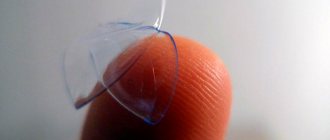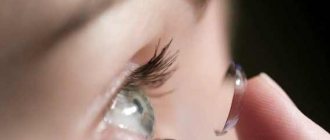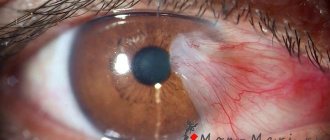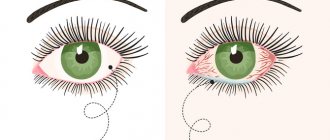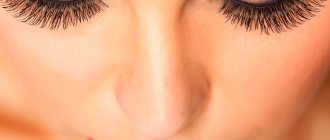Can the lens end up behind the eye?
When positioned correctly, the lenses usually stay in place all day long without causing discomfort. There are several factors that can lead to lens movement:
- the eyeball has a spherical shape, so if you rub the eye hard, the lens can move behind the eyelid;
- dust or damage to the surface of the lens also leads to unpleasant sensations;
- incorrectly selected lens size and shape. Before purchasing, you should consult with a specialist;
- Displacement can also occur if the lens is placed incorrectly (for example, on the wrong side).
In order to avoid unpleasant situations, you should choose lenses in strict accordance with the recommendations of the ophthalmologist. Only a qualified specialist can select the correct lens according to the individual characteristics of the patient.
What to do if the lens falls on the floor – About eyes
Olga Yashina, head of the refraction room at the Ophthalmology Clinic of the Botkin Hospital
1 When wearing contact lenses, you must follow the rules of hygiene: do not put on lenses with dirty hands, put on dirty contact lenses, and do not change the solution in the container for several days.
2 You cannot use lenses, solutions that have expired , or “over-wear” lenses. That is, if the lens is one-day use, then you need to wear it for 1 day. If for a month, then only a month, and then throw it away. Because proteins and fats accumulate on the lens over time, which contaminate the lenses and reduce oxygen permeability.
3 You cannot wet lenses with any liquids, except solutions specifically intended for this purpose, including saliva, tap water, and so on.
How to restore vision: causes of impairment and methods of treatment
4 You cannot swim in the pool without safety glasses . Glasses protect your eyes from water penetration (it contains pathogens that can get into the lens). And a contact lens is an ideal environment for their reproduction.
5 You cannot put drops that are not intended for instillation into contact lenses, because they contain a preservative that can adversely affect the structure of the contact lens.
6 You can sleep in lenses only if this is indicated in the instructions. There are special lenses with prolonged wearing mode and high oxygen permeability.
7 Do not use torn, damaged lenses with torn edges. Otherwise, you can damage the mucous membrane of the eye. You should also not touch the lenses with hard objects or fingernails - this can damage them.
How to preserve vision: advice from an ophthalmologist
Remember 5 more rules that should not be broken when wearing lenses:
Source:
How to break your eyes on lenses
One pair of eyes is good, but two means your visual acuity has decreased. If everything is transparent with glasses, then the lenses sometimes make the owners cry. 99% of those who use these optics make at least one mistake in their use. This leads to corneal infections in 79% of cases.
- “Just Ask” decided not to turn a blind eye to the disappointing statistics and examine the errors under a magnifying glass.
- Olga Yaseva, journalist.
- This article was published on the Just Ask website.
Wear lenses longer than indicated on the packaging
A survey of US patients found that half of consumers simply forget when to change lenses. A quarter of respondents admitted that they continue to wear lenses after the deadline because they don’t have money for new ones.
What is the danger
Over time, fatty and protein particles, dirt and dust accumulate on the surface of the lens. They damage the eye, and microcracks can become infected: most often, microbial keratitis occurs. At the initial stage, the eyes itch and fester; later, vision decreases; in the worst case, the patient may go blind.
Due to prolonged wear, the lens material ceases to allow oxygen to pass through. The lens becomes denser and compresses the cornea - the eye turns red and swells, and pain is felt. This is how dry eye syndrome, stye and corneal neovascularization occur - this is when blood vessels grow into the cornea.
Crib
Set a reminder on your phone so you don't forget to renew your lenses.
Sleeping in lenses
First of all, we are talking about hydrogel optics: about lenses that must be removed at night, and “one-day ones”.
What is the danger
In a dream, the eye, dressed in a lens, almost does not breathe and is not moisturized. This leads to hypoxia - lack of oxygen. This causes the eye to turn red and feel dry and painful.
Sleeping in lenses also increases the risk of developing an infection by 6–8 times. By removing and rinsing your lenses before bed, you clear them of most of the bacteria that has accumulated during the day. And the night in the lenses sends pests on a rampage, which are only happy about the dry and oxygen-free environment of the eye.
Good news. There are lenses with extended wear that you can sleep in. They are made of silicone hydrogel, which is highly permeable to oxygen, and can be worn for 30 days in a row.
Source:
What to do if a lens falls?
Sometimes there are cases when the lens may fall out. And then the question arises, what to do and whether it can be used further.
You need to treat such situations very carefully, because it may happen that you can lose your contact lenses, for example, if you remove them over the sink and forgot to plug the drain hole in advance. If you do not take care of this in advance, you may well find yourself in a situation where the lenses end up in the pipes, which was hardly part of your plans.
Sometimes it can be quite difficult to find a fallen lens, because it falls completely silently, and is also very small, so it can easily fall into any gap. Well, it’s worth mentioning separately about the color of the lenses, because if they are colored, then you are, one might say, lucky, since they are much easier to find than colorless ones.
If you look for your lens for a long time, then over time it may wrinkle and dry out, so even if you find it, it is not a fact that you will be able to identify it, mistaking it for some kind of garbage.
So what to do if you do find it? Handle it very carefully as it becomes very brittle when dried and can crack easily. The fallen lens should be carefully lifted using a piece of paper, after placing it under it.
After you have safely lifted it, you have two options for what to do, depending on what kind of vision correction you are using - daily contact lenses or scheduled replacement lenses. In the first case, of course, they should be thrown out immediately and replaced with the next batch.
If you use contact lenses for a month or a quarter, then place them in a special container with solution overnight. If the next day the lens has not acquired its shape and has not become elastic, it cannot be replaced and will also have to be thrown away.
Also, do not forget that before you insert the lens into your eye, you should thoroughly rinse it with a special solution. If you feel any discomfort after putting it on, this most likely means that it was damaged and will also have to be thrown away and replaced with a new one.
The fact is that after a fall, damage and small scratches could form on it, which cause discomfort when using it.
In such cases, the ideal solution is to use daily contact lenses. As the name suggests, this vision correction device needs to be worn for a limited period of time - only one day.
Agree that this is very convenient - every morning you just need to put on a new sterile lens, and at the end of the day you just take it off and throw it away.
And as mentioned above, even if you accidentally drop it, you can always just throw it away and get a new one without resorting to additional manipulations with the solution.
Source:
What to do if the lens is lost in the eye, and can the lens end up behind the eye?
What to do if the lens is lost in the eye?
When positioned correctly, the lenses usually stay in place all day long without causing discomfort. There are several factors that can lead to lens movement:
- the eyeball has a spherical shape, so if you rub the eye hard, the lens can move behind the eyelid;
- dust or damage to the surface of the lens also leads to unpleasant sensations;
- incorrectly selected lens size and shape. Before purchasing, you should consult with a specialist;
- Displacement can also occur if the lens is placed incorrectly (for example, on the wrong side).
In order to avoid unpleasant situations, you should choose lenses in strict accordance with the recommendations of the ophthalmologist. Only a qualified specialist can select the correct lens according to the individual characteristics of the patient.
First of all, you need to make sure that the lens has actually moved. Thin material and transparency make the product almost invisible. It can be difficult to remove immediately. The reason for this may be dry eyes, in which case special drops are recommended.
If the lens is lost in the eye, you can do the following:
- Apply eye drops several times. A large amount of liquid will help remove the product;
- you will need a mirror. All manipulations must be done in good lighting and with clean hands. Raise your head high so that your chin is almost horizontal. Gently pull back the eyelid and try to see the lens. If it doesn’t work right away, then apply special eye drops. In order for the lens to move, you need to blink frequently. This will help the lens move towards the edge of the eyelid. Then you need to remove it in the usual way;
- If you can’t get the lens out on your own, you should contact an ophthalmologist as soon as possible. A specialist will definitely help you solve this problem.
If the lens remains behind the eyelid for a long time, there is a risk of developing conjunctivitis. To avoid a recurrence of such a situation, you must adhere to all recommendations for wearing lenses and carefully select the product.
Source:
Checking the shape of a contact lens
Before placing a contact lens on your eye, make sure it is not inside out (inside out). Place the contact lens on the tip of your finger so that it looks like a cup.
Hold the contact lens up to your eyes and look at it from the side. If its shape is similar to a hemisphere, then everything is in order and the contact lens can be put on the eye.
If the edges of a contact lens are bent outward, it is inside out and must be shaped correctly.
Many contact lenses now have a so-called inversion indicator (usually several symbols located along the edges of the contact lens). If you can read these symbols, then everything is in order, if not, the contact lens is turned inside out.
Don't worry, if you put on a contact lens turned inside out, you will immediately feel discomfort. Take it off. Once the contact lens is shaped correctly, put it back on.
Putting on a contact lens
- Wash your hands thoroughly. Avoid using soaps with a moisturizing or softening effect, as the substances contained in such soaps can be carried into the eyes along with the contact lens. Especially avoid detergents with linolin.
— Gently shake the contact lens case to loosen the contact lens if it is stuck to the surface of the case. Do not try to remove it from the container with your finger - you may damage it.
— Carefully take the contact lens and place it in your palm. Rinse it completely with fresh MFR.
— Place the contact lens on the tip of your index or middle finger, which should be dry and slightly damp. - Using the fingers of your other hand (thumb and index or middle), simultaneously lift the upper eyelid and lower the lower eyelid.
— Place the contact lens on your eye, looking up or down (whichever is more comfortable for you). You can also place the contact lens not in the center of the eye, but on the side (on the white part of the eye, closer to the ear).
- Release the eyelids held by your fingers. Cover your eye. Rotate your eye to get the contact lens in place, then blink.
ADVICE:
Always place the contact lens from the right compartment of the case on your right eye, and vice versa, to avoid mixing up your right and left contact lenses.
Removing a contact lens
— Always wash your hands before removing contact lenses. If you remove contact lenses over a sink, cover the sink drain with a clean, lint-free towel to prevent a contact lens you accidentally drop from getting in.
Source: //4hospital.ru/bolezni/chto-delat-esli-linza-upala-na-pol.html
What to do if the lens is lost in the eye?
First of all, you need to make sure that the lens has actually moved. Thin material and transparency make the product almost invisible. It can be difficult to remove immediately. The reason for this may be dry eyes, in which case special drops are recommended.
If the lens is lost in the eye, you can do the following:
- Apply eye drops several times. A large amount of liquid will help remove the product;
- you will need a mirror. All manipulations must be done in good lighting and with clean hands. Raise your head high so that your chin is almost horizontal. Gently pull back the eyelid and try to see the lens. If it doesn’t work right away, then apply special eye drops. In order for the lens to move, you need to blink frequently. This will help the lens move towards the edge of the eyelid. Then you need to remove it in the usual way;
- If you can’t get the lens out on your own, you should contact an ophthalmologist as soon as possible. A specialist will definitely help you solve this problem.
If the lens remains behind the eyelid for a long time, there is a risk of developing conjunctivitis. To avoid a recurrence of such a situation, you must adhere to all recommendations for wearing lenses and carefully select the product.
Several questions for people who wear contact lenses for vision correction and received the best answer
Answer from Ashan Ashan [guru] well, there are contact lenses and for 3 months and six months they cannot fall out of the eye unless you rub them yourself. a couple of hours is possible, I don’t recommend more (they must be constantly moistened when blinking, otherwise they will dry out) the ambient temperature does not affect the lenses (if they are on the eyes) during acute respiratory viral infections or other infectious diseases, it is not recommended to wear lenses, because lenses in the power of their structure absorbs everything and everyone, including microbes and so on, then inflammation can occur. Smoking while wearing lenses is also not recommended. if there is a temporary increase in temperature, then it’s okay if it falls on the floor - pick it up and rinse with lens solution (it must be disinfectant)
Answer from Evgeny Unichenko
[active] The doctor said to wash only with a solution. Do not use water. The lens will absorb bleach.
Reply from Christina Chris
[gurus] need to be changed every month because they kind of wear out, the image over time is not as clear as at the beginning. They cannot fall out of the eye due to a strong fall or sneezing; on the contrary, at first, until you learn how to put them on and take them off, there will be difficulties. You can sleep for a couple of hours without removing the lenses, but you will feel your eyes burning and discomfort. There is no need to wear clothes when you have a cold, because at this time the body is very sensitive to viruses and bacteria, and you can catch an infection in your eyes. Air temperature -15 and below cannot affect the lenses. If the lens falls somewhere on the floor or some other dirty place, you are unlikely to find it, and if you do find it, it is better not to use it, you will get an infection. In general, the thing is very convenient, at first there may be difficulties, but after about half a month or a month you won’t even feel it))) Doesn’t depend on age))
Answer from Alexey Dubin
[active] Ahhah, so many problems) I wore for about 7 years, living my life to the fullest, and they only fell out when I casually hit my eye with my finger/fist, directly touching the lens. Somehow I fell asleep in one-day shorts in my outfit - they dried out, fell out, but they were denser, not for sleeping (but more oxygen-permeable), in the rest they never fell out, I dived, my eyes flooded with water because I didn’t close them tightly, I blinked - normal. When I’m sick, I sit at home wearing glasses like an intellectual in a robe, where to go out, always wearing lenses, but one-day ones and the norm. But it’s better not to pick them up from the floor, I’m disdainful of putting on one-day-old ones from a sterile blister (but with -5 I have to), I don’t know how Then you put it in the solution and put it on))).
Reply from Elena
[guru] Our accountant’s daughter was very fond of lenses and was careless about the rules for their use. I got keratitis (inflammation of the cornea of the eye) with fever and pain in the eyes - I was taken to the hospital by ambulance. So be careful with lenses.
Answer from Natasha Usenko
[active] Because they have a limited shelf life, there are lenses for three months, there are for a month, there are even daily ones. I once lost it because I rubbed my eye very hard, but when I sneeze and fall, I think not, because when a person sneezes, he closes his eyes. I was sleeping, this is not advisable, but nothing criminal happened to me or my lenses. I think not, because you can wear lenses in winter. Microbes that get into the eye cannot escape because the lens is in the way, which can cause discomfort and further illness. If you're at home, it's better to take it off, it definitely won't do any harm. I’ve had it fall several times, just rinse it well, if possible under the tap, but with low pressure, otherwise God forbid you’ll wash it off.
Reply from Jenny
[guru] 1. Because they are made of thin polymer that breaks down. There are coarser lenses with a replacement period of 3 months and 6. There are also thin ones - their period is a day. 2. No, firstly, when you sneeze, you instinctively close your eyes, and the diameter of the lens is large (here in front of me - 14.2 mm) and it goes behind the eyelid, so you can hold it. 3. Yes, of course it is harmful - the presence of a lens increases the pressure in the eyeball. But taking a nap on the bus is sacred!! ! 4. The lenses are glued to the eye - and they are as warm as the eye. Even at -35 (Checked). 5. There is a general weakening of the body and impaired lacrimation due to a runny nose and general stress. And in general - it’s tempting to sleep - and then see point 3. Although they wear it. 6. It can be bad even at a temperature of 36.6 - it’s a matter of the state of the body. 7. Rinse, there are special solutions. You store them as you wish and clean them from protein deposits. You will have 2 more buckets with special equipment. They fall on my mirror all the time. Got wet - and in front.
Reply from “Only girls in jazz!!!”
[guru] Lenses tend to get dirty, so they are replaced. They can fall out when swimming, diving, in the shower, when washing. Theoretically they can fall out from sneezing, but in practice I have not had such cases. You can sleep all night. I haven’t noticed the effect of temperature on the lenses, I wear them in cold and hot weather, also during flu, acute respiratory infections, ARVI, I don’t bother too much with it. If you fall, pick it up, clean it, you can continue wearing it.
Sometimes there are cases when the lens may fall out. And then the question arises, what to do and whether it can be used further.
Such situations must be treated very carefully, because it may happen that you can lose them, for example, if you remove them over the sink and forgot to plug the drain hole in advance. If you do not take care of this in advance, you may well find yourself in a situation where the lenses end up in the pipes, which was hardly part of your plans.
Sometimes it can be quite difficult to find a fallen lens, because it falls completely silently, and is also very small, so it can easily fall into any gap. Well, it’s worth mentioning separately about the color of the lenses, because if they are colored, then you are, one might say, lucky, since they are much easier to find than colorless ones.
If you look for your lens for a long time, then over time it may wrinkle and dry out, so even if you find it, it is not a fact that you will be able to identify it, mistaking it for some kind of garbage.
So what to do if you do find it? Handle it very carefully as it becomes very brittle when dried and can crack easily. The fallen lens should be carefully lifted using a piece of paper, after placing it under it. After you have safely lifted it, you have two options for what to do, depending on what kind of vision correction you are using - daily contact lenses or scheduled replacement lenses. In the first case, of course, they should be thrown out immediately and replaced with the next batch. If you use contact lenses for a month or a quarter, then place them in a special container with solution overnight. If the next day the lens has not acquired its shape and has not become elastic, it cannot be replaced and will also have to be thrown away. Also, do not forget that before you insert the lens into your eye, you should thoroughly rinse it with a special solution. If you feel any discomfort after putting it on, this most likely means that it was damaged and will also have to be thrown away and replaced with a new one. The fact is that after a fall, damage and small scratches could form on it, which cause discomfort when using it.
In such cases, the ideal solution is to use daily contact lenses. As the name suggests, this vision correction device needs to be worn for a limited period of time - only one day. Agree that this is very convenient - every morning you just need to put on a new sterile lens, and at the end of the day you just take it off and throw it away. And as mentioned above, even if you accidentally drop it, you can always just throw it away and get a new one without resorting to additional manipulations with the solution.
In films, you could see how the main character is walking down the street or having a casual conversation and suddenly realizes what is in his eye. Does this happen in real life? No, because it fits tightly to the surface of the cornea. Certain conditions are required for it to fall out.
Cases in which it may fall:
- awkward handling of the lens when placing it in a container or removing it from there;
blinking of the eyes or poorly coordinated finger movements when putting on the SCL;
active rubbing of the eyes with hands when feeling discomfort or contact with foreign bodies.
What to do?
The drug “Biotrue” will help cope with the problem.
When the correction products have dried outside the visual organs and are in the container, you can try to restore elasticity with the help of moisturizers. Ophthalmologists recommend a solution of Biotrue and Maxima Elite, which soften and lubricate the plates. It is strictly forbidden to touch the lenses in the container with your hands, as you can introduce pathogenic microflora and damage the integrity of the material.
The optimal duration for ophthalmic agents to remain in the solution is 4-6 hours. Then you need to carefully pull out the plates and apply lubricating fluid to them. Before putting it on, moisturizing drops should be placed into the organs of vision. It is recommended to repeat the procedure 2-3 times a day. The container in which the transparent plate has hardened should be thoroughly washed and further disinfected. If cracks are found, you need to buy a new one.
When the lens dries directly in the eye shell, it is necessary to promptly use moisturizing and relieving irritation drops:
- "Interferon";
- Optimized Drops;
- "Levomycytin";
- "Albucid";
- "Artelak Splash";
- "Erythromycin".
A particular danger of a lens drying out during use is the difficulty of remediation. There is a high risk of scratching the cornea on your own and causing an infection.
The softened material, when installed in the eye, should not cause cutting, pain, burning or discomfort. Blurred images and blurred vision indicate irreversible damage to the structure of the material. The appearance of redness of the skin of the eyelids and itching are symptoms of infection, which can provoke an inflammatory process. The appearance of such a negative reaction from the body indicates the need to throw away the lenses and buy new ones.
How to find a lens that fell on the carpet
All MKLs (with the exception of ) are completely transparent or have a slight, barely noticeable tint, which makes them extremely difficult to detect on the carpet. Moreover, they are very light and can float in the air like “flying saucers.” Such lenses are capable of falling in the most unexpected places without making a single sound. Naturally, searching for them can be very difficult.
You can find a lens that has fallen on the carpet or floor using a vacuum cleaner. Before starting the search, you should put a thin nylon stocking on its nozzle. This will allow you to “scan” the area of the floor where the MCL may have fallen. To avoid accidentally damaging the lens, during searches you need to carefully move the vacuum cleaner at a distance of 2-3 cm from the floor. When the “lost” is on the surface of the stocking, you can turn off the vacuum cleaner and pick it up from there. Afterwards the lens can be worn again.
The lens fell to the floor
I will say as an owner of contact lenses: if you immediately find a dropped lens, rinse it in a solution, and then put it on, then in most cases there will be no unpleasant moments.
Another thing is that here you need to take into account the following feature: being outside the eye and the solution, the lens dries out very quickly, especially its edges. If you find it too late, it will already be very dry, the edges will be wavy, and you’ll just have to throw it away. Soaking in the solution will not help.
A girl I know told me: one day, while in a club, she somehow lost her lens. And in the dark, I honestly don’t know how, she managed to find it under the table and put the lens on her eye without solution. It’s good that everything worked out, but this is of course extreme).
I myself had a lens fly under the table several times, and it was not always possible to find it right away. A couple of times it happened that I had to simply throw out the lens, and this, as you know, is not a cheap product. Now, in order to exclude such an incident, I try to put the lens directly above the table to prevent the possibility of it falling on the floor.
If the SCL is immediately found and cleaned mechanically and put into the solution, there will be no unpleasant surprises. It is advisable to put an enzyme tablet in the container or clean it with a peroxide system.
After cleaning, a fallen contact lens, if it is without tears or scratches, can be put on again without fear of infection.
If the optical aid is not immediately detected, lift it from the floor with great care. Leaving the CL out of solution for a long time leads to drying out of the material. Becomes fragile and may break. If the edges are wavy, you will have to throw it away. Soaking the CL in the solution will not help return it to its previous shape.
The optics should be placed over a sink, bathtub or table. If the user is on an airplane or train, it is necessary to ask a companion to hold a piece of paper under the chin to prevent the MCL from falling onto the floor or into the sink used by thousands of passengers.
It is important to exclude the possibility of it falling on the floor, so it is easier to find the device and immediately place it in a container with a cleaning composition.
We recommend reading: Is it possible to wash the lens with water?
How to find a dropped lens?
Properly worn lenses adhere very securely to the cornea, and it is almost impossible to lose them. However, it often happens that at the moment of putting on or taking off, a moment of awkwardness leads to the lens falling, and it is very difficult to find it on the floor.
If you crawl on your knees and fumble blindly on the floor with your hands, there is a high risk of damaging a dropped lens. The safest way to pick up a lost lens is to put a thin stocking on the vacuum cleaner nozzle, turn on the power and carefully “scan” the area of the floor where the lens might have fallen.
After lifting the lens from the floor, it is necessary to clean it especially thoroughly. First, soak the lens in the solution for 10-15 minutes to restore normal humidity levels, then gently rub the lens with your fingers in a circular motion, and finally rinse it clean with the solution. No other detergents are suitable for cleaning soft contact lenses.
If quite a lot of time has passed since the fall, then you cannot immediately pick it up. The lens can easily “fall apart” because I was not in a humid environment for a lot of time.
In this case, drip the solution you use for cleaning onto the lens and let it soak in the solution for 10-15 minutes.
And only after the lens has become elastic again can the lens be picked up by hand and placed in a container with a solution for hydration and cleansing.
If too much time has passed and the lens has already become fragile, then it can no longer be restored, because she is irrevocably damaged. And if it is nevertheless possible to “reanimate” it, then the period of its use will be very short due to the microcracks that have arisen.
Magazine
What fell and disappeared? The well-known five-second rule answers this question in the negative. According to him, food that has fallen on the floor can be picked up and eaten without harm to health if it is done quickly - supposedly in five seconds, bacteria simply do not have time to get on the food and it remains safe for the body.
Scientists have tested this rule more than once. If you try to summarize the research results, five seconds is more than enough for microbes. What is much more important is not even the time, but the type of coating and its contamination and, of course, the type of food. Thus, carpeting is much safer than smooth surfaces, and wet food absorbs much more bacteria than dry food.
If a contact lens falls on the floor, the five-second rule does not work. The wet surface of contact products is simply a heavenly place for bacteria to appear and multiply.
- If you drop your replacement lens, don't rush to put it back on. First, thoroughly clean and rinse in a solution to eliminate the risk of infection in the eyes. Then put it on and if you feel discomfort, take it off again and repeat the procedure.
- If you use daily lenses, make it a rule to carry spares with you. Just for such a case. And just throw away the lens that fell.
Lack of high-quality and thorough care for contact lenses is one of the main mistakes that users make. Meanwhile, the health and comfort of the eyes directly depends on this. So don’t neglect the rules of care; it’s better to remember and follow them once and for all:
- Wash your hands every time you put on and take off products, and wipe them dry before handling lenses.
- Do not rinse the lenses and the container with plain water. The impurities it contains can damage the products.
- Clean your contact lenses with a special solution immediately after removing them.
- Clean and change your lens containers on a regular basis.
If you do not want to spend time caring for your lenses, we recommend using one-day products. Ophthalmologists and optometrists praise them for their safety in use: every day you put on a new and sterile lens.
Source: //shuvarida.ru/linza-upala-na-pol/
How to properly clean a fallen lens
When picked up from the floor or sink, the SCL must be washed with lens care product. For this you can use almost everything (except for those that). If the SCL is very dirty, it is better to disinfect it again.
Note that not all fallen SCLs remain suitable for use. Some of them become scratched and even deformed. Wearing such lenses is strictly prohibited, as this can lead to the development of complications. If the SCL is torn, scratched or has been lying on the floor for a long time, it is better to throw it away immediately.
Contact lenses are designed in such a way that when put on, they lie exactly in the middle of the eyeball, just at the level of the pupil. When a person moves his eyes, closes his eyelids, blinks and makes other movements, the lenses stay tightly in place and provide good vision in any situation, so they are more convenient to use than glasses that can fall, break, or move. When contact lenses are used correctly, they cannot get lost.
The smallest speck of dust or scratch on a thin material can also cause discomfort.
Another reason for lens loss is an incorrectly selected diameter. The choice should be made by a specialist who will make all the necessary measurements, including the radius of curvature and diameter. Correctly selected lenses immediately fit correctly on the eyeball, and cups that are too large or small move when blinking or moving the eyes.
What to do if you lose a lens in your eye?
If you decide to remove the lens and find that you can't find it in your eye, first make sure that it has actually moved out of place. The lenses are transparent and thin, they are almost invisible on the eyeball and are difficult to see. Usually they are removed with a slight movement of two fingers, directed from the edges to the center - if as a result the cup does not separate, it seems that the lens simply does not exist. In fact, sometimes the lens is difficult to remove if it is not sufficiently moistened. This method of vision correction dries the eyes, so ophthalmologists advise using special drops. Apply eye drops and try to remove the lens again.
Your vision will also help you make sure that the lens is lost: if it has deteriorated sharply, it means that it does not cover the pupil.
If you are convinced that the lens is really not in place, try to remove it from under the eyelid using repeated drops - the liquid will help the edge “float” out, after which you need to grab it and pull it out. It’s more convenient to do this not on your own, but to ask another person.
If you cannot remove the lens, contact your ophthalmologist. It is advisable to do this as quickly as possible; the longer the lens remains in the eye, the more likely it is to develop conjunctivitis.
